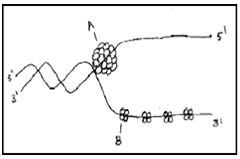Molecular Basis of Inheritance - Online Test
Q1. Which statement is not correct about the DNA?
Answer : Option B
Explaination / Solution:
DNA content is halved during meiosis cell division and not during mitosis cell division. Chromosome is made of DNA protein and same amount of DNA is present in all cells of an individual.
Q2. Beadle and Tatum showed that each kind of mutant bread mould they studied lacked a specific enzyme. Their experiments demonstrated that
Answer : Option B
Explaination / Solution:
Sir Archibald Garrod, a British medical doctor, was the first to suggest that genes were connected to enzymes.
George W. Beadle (1903-1989) and Edward L. Tatum (1909-1975) show genes direct the synthesis of enzymes that control metabolic processes using genetic and biochemical studies of the bread mold Neurospora.
Q3. A single strand of nucleic acid tagged with a radioactive molecule is called
Answer : Option C
Explaination / Solution:
A probe is a fragment of DNA or RNA of variable length (usually 100–1000 bases long) which can be radioactively labeled. It can then be used in DNA or RNA samples to detect the presence of nucleotide sequences (the DNA target) that are complementary to the sequence in the probe.
Q4. A phenomenon where the third base of t-RNA at its 5’ end can pair with a non-complementary base of m-RNA is called
Answer : Option D
Explaination / Solution:
In 1966, Francis Crick proposed the Wobble Hypothesis. He postulated that the 5' base on the anticodon, which binds to the 3' base on the mRNA, was not as spatially confined as the other two bases, and could, thus, have non-standard base pairing.
Crick creatively named it for the small amount of play that occurs at this third codon position. Movement ("wobble") of the base in the 5' anticodon position is necessary for small conformational adjustments that affect the overall pairing geometry of anticodons of tRNA.
Q5. DNA has equal number of adenine and thymine residues (A = T) and equal number of guanine and cytosine (G = C). These relationships are known as
Answer : Option A
Explaination / Solution:
Chargaff's rules states that DNA from any cell of all organisms should have a 1:1 ratio (base Pair Rule) of pyrimidine and purine bases and, more specifically, that the amount of guanine is equal to cytosine and the amount of adenine is equal to thymine.
Q6. What does A & B represent?


Answer : Option C
Explaination / Solution:
In figure above, A represent helicase and B represents single strand binding protein. These structures are formed during semi-conservative replication of DNA.
Q7. In DNA, sugar is attached to nitrogenous base (purine or pyrimidine) through
Answer : Option D
Explaination / Solution:
In DNA, sugar and nitrogenous base are attached with each other through glycosidic bond. Phosphate and next sugar with Phosphodiester linkage and purine and pyrimidine with hydrogen bonds.
Q8. In the DNA molecule:
Answer : Option C
Explaination / Solution:
In the DNA molecule, there are two strands which run antiparallel one in the 5′→3′direction and other in the 3′→5′.
Two strands are combined by Hydrogen bonds between nitrogenous bases of complementary strands.
Q9. Copying of DNA to make more DNA copies is called DNA replication. Replication occurs by method of
Answer : Option A
Explaination / Solution:
In semiconservative replication, when the double stranded DNA helix is replicated, each of the two new double-stranded DNA helices consisted of one strand from the original helix and one newly synthesized. It has been called "the most beautiful experiment in biology.
Semi-conservative replication of DNA was proved by the Meselson and Stahl in 1958.
Q10. HIV is classified as a retrovirus because its genetic information is carried in
Answer : Option C
Explaination / Solution:
Retrovirus is a type of virus that uses RNA as its genetic material. After infecting a cell, a retrovirus uses an enzyme called reverse transcriptase to convert its RNA into DNA.
The retrovirus then integrates its viral DNA into the DNA of the host cell, which allows the retrovirus to replicate. HIV, the virus that causes AIDS, is a retrovirus.
